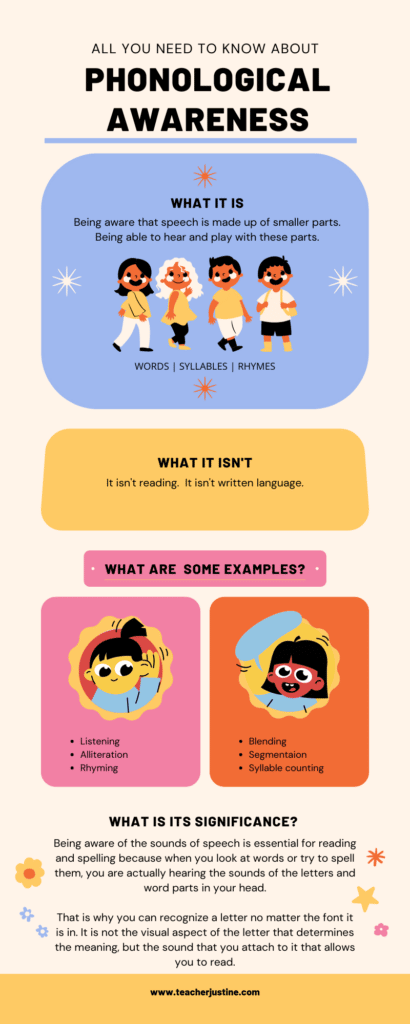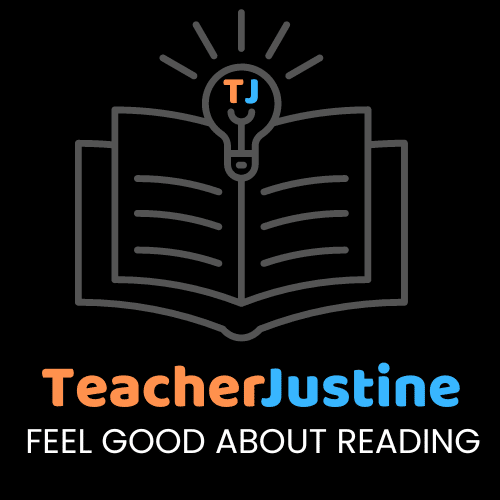Teacher Justine contains affiliate links and is a member of the Amazon Services LLS Associates Program. If you make a purchase using one of these Amazon links, I may receive compensation at no extra charge to you. See my disclosure policy for more information.
11 Fun Phonological Awareness Activities at Home
Phonological awareness activities at home are fun and will help your child develop reading skills. By playing with rhyming and saying silly sentences, your child will become aware of words and sounds and will develop the skills they need to learn to read and spell.
Build the 11 fun phonological awareness activities into your daily routine
You can build these fun games into your daily routines all day long. At the grocery store, while driving in the car, waiting at the airport, playing in the park. Here are some of my favorite phonological awareness activities and games to do with your children anytime, anywhere.
Number 1: Nursery rhymes
Nursery rhymes are easy to memorize. You can add hand movements and make them even easier to memorize. Your kids will ask for them over and over cementing the sounds and rhymes into memory. If you just memorize a few nursery rhymes and add some hand movements, you can do them anytime, anywhere. You probably already know some of these from your own childhood. My favorites are:
- Ba Ba Black Sheep
- Humpty Dumpty
- Jack and Jill
- Peter Peter Pumpkin Eater

Number 2: Just say a part
In this game, you say a sentence. Have your child repeat the sentence. Then you say, “now just say a part of that”. They repeat the sentence and leave off the last word or two. Then you say, “now say part of that”. You keep doing this until there is only one word left in the sentence. This is a great exercise to strengthen listening skills and memory. And it is easy to make up a simple sentence anywhere anytime, like when you are driving in the car. Here is an example:
Parent: A rabbit hopped through the garden.
Child: A rabbit hopped through the garden.
Parent: Now, say part of that.
Child: A rabbit hopped through.
Parent: A rabbit hopped through – say part of that.
Child: A rabbit hopped.
Parent: A rabbit hopped – say part of that.
Child: A rabbit
Parent: A rabbit – now say part of that.
Child: A
Number 3: Listening for same or different
Tell your child you are going to make some sound patterns by clapping your hands or snapping your fingers. Tell your child to say “same” if the sounds are the same, and say “different” if the sounds are different. Try this:
Parent: clap, clap
Child: same
Parent: snap, snap
Child: same
Parent: clap, snap
Child: different
Now turn around or hide your hands and do it again. You can also think of other sounds you can make, like knocking your knuckles on the table or rapping your fingernails on the table.
Number 4: Counting syllables
This could be fun to do at the grocery store when picking out produce. Point to the strawberries and say “how many syllables does strawberry have?” Then clap out the word with your child: straw/berr/y. Three! You can just go up and down the produce aisles saying and clapping:
/ba/na/na/
/ru/ta/ba/ga/
/grapes/
/carr/ots/
/a/vo/ca/do.
You don’t have to get scientific about where the word breaks into syllables. Different dictionaries do it in different ways. Just break it where it seems natural. Later on, when they are reading syllable by syllable, there are ways to break it that help with the correct pronunciation, but for now, just do what seems natural when you say it.
Number 5: Silly sentences
Make up sentences where all the words start with the same sound. A good one to start with is the letter M.
Mad Mary made many messy mudpies.
Have your child repeat the sentence. Then say it again and have them notice your mouth and lips when you say the sentence. Ask them what happens to my mouth? Are my lips together when I say each word? Ask them if they can say this sentence with their lips open. Try it. This will make them laugh and notice that our lips start together when we say words that begin with M.
Now say another sentence where all the words start with the letter S. Ask your child to watch your mouth and ask are my teeth together when I start to say each word? Then change a word at the end and ask the questions again.
Silly Sally said she saw seven swans.
Silly Sally said she saw seven cows.
Number 6: I say, you say
In this game, you say a word and your child has to say a word that rhymes with it. Start like this:
I say hat, you say _____. (bat, mat, rat, etc.)
I say rug, you say _____. (bug, mug, dug, etc.)
I say pan, you say _____. (ran, fan, man, etc.)
This game will make them laugh and invent new silly words. Again, you can play this game anytime, anywhere.
Number 7: More silly sentences
In this game, say a sentence where all the words start with the same sound. Leave off the last word. Then have your child repeat the sentence and add in the last word. The word has to start with the same sound.
Careful cautious cats catch ________(cod, candy, kittens).
Messy Molly made many more _________(muffins, marshmallows, muppets).
This game can be hard for children, so you can also ask “Do careful cautious cats catch cod?” The answer is yes. “Do careful cautious cats catch mice?” The answer is no.
Number 8: Oops! Wrong Rhyme
This game is very silly and fun. You say a sentence, like “This is my rose”, while pointing to your nose. Then you say “oops, wrong rhyme. I mean this is my_______.” Then your child fills in the correct rhyme. Then say, “yes! rose and nose rhyme.” You can do this will many of your body parts:
This is my sand. Oops! Wrong rhyme! I mean this is my _______. Yes, sand and hand rhyme.
This is my fin. Oops! Wrong rhyme! I mean this is my ________. Yes, fin and chin rhyme.
This is my pie. Oops! Wrong rhyme! I mean this is my _______. Yes, pie and eye rhyme.
You can also do this with objects in the room. “This is my ramp,” and point to the lamp. “This is my stable,” and point to the table. Again, this is a silly and fun game that can be played anywhere, anytime.
Number 9: Odd one out
Say three words. Have your child repeat the words and then tell you the one that doesn’t rhyme. Start with the odd one out at the end because this is easier. It gets trickier when the odd one out is in the middle:
mat/cat/stop
run/fun/back
book/bike/look
deep/peep/up
Number 10: Do these words rhyme?
This is easier than odd one out. Just say two words. Then ask your child to repeat and tell you if they rhyme.
cat/hat Yes
boy/toy Yes
round/sound Yes
yes/my No
top/pot No
tip/pip Yes
tip/tap No
Number 11: Two in one
In this game, say a compound word, like cupcake. Have your child repeat it and name the two words they hear in the word:
cupcake – cup cake
football – foot ball
sunshine – sun shine
chalkboard – chalk board
pancake – pan cake
rainbow – rain bow
This is a great game because it is easy and helps children realize that longer words are made up of smaller words and parts. This will set them up for reading long words by breaking them into parts.
Bonus: Reading rhyming books
I put this one last because although you can do it anywhere, anytime, you do need to have a book. This one is perfect for the end of a long day. Rhyming books are so fun to read to children. They are easy to read orally and they give us energy instead of zapping us after long day. Kids love them because they are so silly and they have rhythm. My favorite way to read rhyming books to children is to read just up to the second rhyme in the verse and have the kids shout out the rhyming word.
Play games and have fun!
Have fun with these phonological awareness activities at home. I love them because they require no materials. They can all be done anywhere, anytime. I found many of these activities in a book called Reading Readiness published by the Neuhaus Education Center. The book has many more activities, but I chose these because they require no materials. Present them as games and your child will be laughing while developing phonological awareness or becoming aware of sounds in language. Do these games every day at different times of the day and they will become aware and curious about sounds. This will set them up for reading and spelling success.
If you like these reading readiness tips and want to receive weekly blogs from me about topics related to the 4 stages of reading, then click here to sign-up for my email list and also receive my free Reading Guide. And check out my related blog on other activities you can do for reading readiness.
